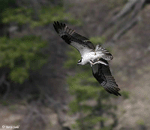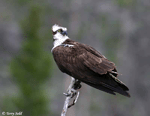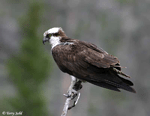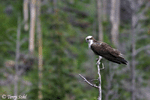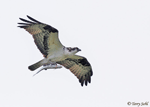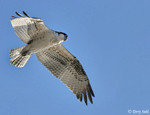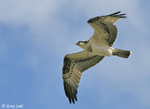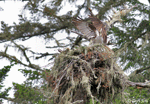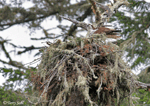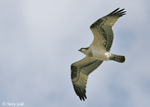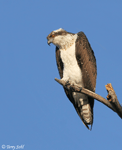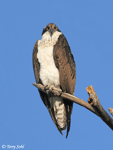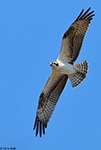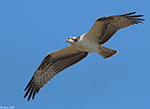Osprey
Pandion haliaetus
| Length: 20 - 24 inches | Wingspan: 54 - 72 inches | Seasonality: Migrant / Rare Breeder |
| ID Keys: White head with black facial stripe, dark body with white underparts, distinct bend in wing while flying | ||
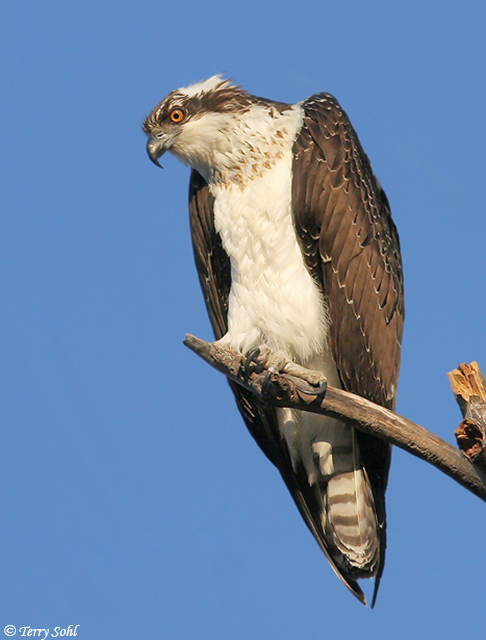 Known locally as the "fish hawk", Ospreys are strongly
associated with water, as their diet is almost exclusively fish. They have
unique feet compared to other raptors, with a reversible outer toe and small
"spicules" (spines) on the bottom of their feet that help them capture and hold
on to their preferred slippery prey. Much
better fishers than their larger competitor the
Bald Eagle, in many areas Bald Eagles obtain much
of their food by harassing Ospreys and stealing their prey.
Known locally as the "fish hawk", Ospreys are strongly
associated with water, as their diet is almost exclusively fish. They have
unique feet compared to other raptors, with a reversible outer toe and small
"spicules" (spines) on the bottom of their feet that help them capture and hold
on to their preferred slippery prey. Much
better fishers than their larger competitor the
Bald Eagle, in many areas Bald Eagles obtain much
of their food by harassing Ospreys and stealing their prey.
Ospreys were nearly decimated by the effects of DDT and other pesticides by the middle of the 20th century, but have strongly rebounded over the past few decades. In South Dakota, Ospreys are most easily found at select, noted nesting areas in the Black Hills. Attempts have been made in recent years to encourage nesting in other locations as well, including the placement of nesting platforms and the release of captive-raised birds below Gavin's Point Dam along the South Dakota / Nebraska border.
Habitat:
Ospreys can be found near many aquatic habitats, both fresh- and salt-water. They are more common around coastlines, but also can be found near large rivers and lakes. Inland nesting is becoming more common as the species rebounds from the population crash of the 20th century.
Ospreys feed by grabbing fish within a few feet of the water's surface, and thus habitat is dependent upon suitable foraging areas that either 1) have large areas of shallow water where fish can be easily seen and captured, or 2) areas near fish species that tend may be found in deeper water, but tend to swim close to the water's surface.
Diet:
Nearly an exclusive diet of fish. On very rare occasions, they will feed on small birds, rodents, snakes, and lizards.
Behavior:
Hunts by flying slowly over water, stopping to hover when prey is spotted, and plunging into the water feet first to catch the fish in its talons. They are not divers, but capture fish that are relatively close to the surface.
In courtship, pairs can often be seen circling together high in the sky. Males also sometimes perform a dance for the female, often initiated after capturing a fish, where the male then alternatively hovers and dives in a display above the nest site.
Nesting:
May and June. Given the Osprey's fish-filled diet, nesting occurs near suitable aquatic habitat, although they will nest up to 10 miles from feeding locations if nesting options are limited. The nest is placed in an open area with good visibility and protection from ground-dwelling predators. It could be placed on a cliff face, the top of a tall dead snag or live tree, or often in recent decades on a human structure. This may include both nesting platforms constructed specifically for osprey nesting, or the top of a powerline pole or other tall human structure.
The nest of an Osprey can be a massive structure, constructed of sticks and twigs, and sometimes lined with finer material such as grasses, other vegetative material, or bits of debris. The same nesting site is often used year after year, and what begins as a small structure in the first year of nesting may grow over the years to a truly massive structure of over 10 feet in diameter and weighing many hundreds of pounds.
The female lays between 2 and 4 eggs (typically 3 eggs), with both parents helping to incubate the eggs. The young hatch after about 35-40 days. At first, the female stays with the young while the male gathers food for the family. Later, both parents may be out searching for food with the young left alone in the nest. The young don't fledge from the nest until between 6 and 9 weeks after hatching.
Song:
Ospreys have a high-pitched, harsh, whistled cry, given with varied intensity and pace. The speed and volume of the call is often correlated to the danger of a perceived threat.
1Click here to hear the cries of a female Osprey landing on its nest
2Click here to hear the begging calls of a young hatchling in a nest
3Click here to hear the alarm and flight calls of an Osprey
Migration:
Summers throughout much of Canada, Alaska, and locally in the western U.S., the Great Lakes region, and near U.S. coastlines. Most Osprey migrate in the fall, with the exception of those in Florida and along the Gulf Coast. Wintering range of the Osprey is along the Gulf Coast, Florida, the California Coast, and southward through Mexico, Central America, and South America.
Interactive eBird Map:
Click here to access an interactive eBird map of Osprey sightings
Similar Species:
Generally distinctive if seen well. However, if seen from a distance or in poor conditions, they could potentially be confused with the following species:
- Bald Eagle - Listed here largely because 1) both species are large raptors with dark upperparts and a predominantly white head, and 2) they are often found in conjunction with each other, given each species' fondness for hanging out near large water bodies. If seen well, however, the two can be easily differentiated. Ospreys have white underparts, while Bald Eagles (both juvenile and adult plumage) have dark underparts. The head of an Adult Bald Eagle is pure white, while the head of a juvenile is mostly dark. Contrast that with the overall white head and neck of a Osprey with a broad black mask through the eye.
Status:
Osprey numbers were severely depleted in many parts of the world by the mid- to late-20th century. Hunting and direct persecution were issues in many parts of their range, but in North America, the primary cause of decline was the presence of pesticides such as DDT. Osprey numbers (and other bird species, most notably the Bald Eagle) declined precipitously between the 1950s and the 1970s due to the pesticides, which were found to cause severe eggshell thinning that resulted in failed nesting attempts. By the 1970s, the Osprey was seriously endangered in North America. With the banning of DDT, the Osprey has rapidly recovered in numbers and range in North America, although it has yet to fill all ecological niches and areas that it used prior to the 20th century declines.
Osprey numbers continue to increase, and every year, they're nesting in areas where they haven't nested in years. With their broad geographic range and rebounding numbers, the IUCN considers the Osprey to be a species of "Least Concern".
South Dakota "Hotspot":
Osprey have nested below Pactola Dam in the Black Hills in recent years. They can often be found below Missouri River Dams as they migrate in the fall. I've particularly had good luck finding multiple birds below Gavin's Point Dam in the mid- to late-fall.
Further Information:
Photo Information:
November 1st, 2007 - Gavin's Point Dam, along the Nebraska / South Dakota border - Terry Sohl
Additional Photos:
Click on the image chips or text links below for additional, higher-resolution Osprey photos.
Audio File Credits:
1Simon Elliott - Near Ferness, Highland Council, Scotland, from June 11th, 1999. Original recording and information from xeno-canto.
2Simon Elliott - Near Ferness, Highland Council, Scotland, from July 2nd, 1999. Original recording and information from xeno-canto.
3Eetu, Paljakka - Near Haapala, Kouvola, Kymenlaakso, Finland from June 13th, 2020. Original recording and information from xeno-canto.
| Click on the range map for a higher-resolution view |
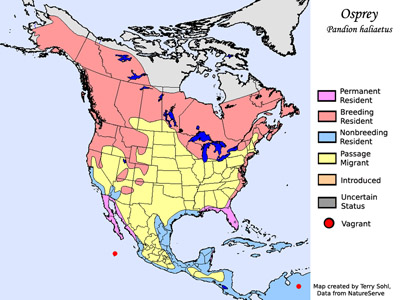 |
| South Dakota Status: Uncommon migrant throughout the state. Rare summer breeding resident in the Black Hills. |
Additional Osprey Photos
Click for a higher-resolution version of these photos
